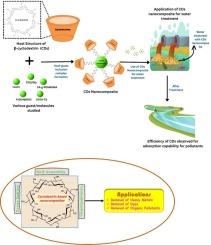下一代修复工具:环糊精基纳米复合材料综述
Q1 Environmental Science
Environmental Nanotechnology, Monitoring and Management
Pub Date : 2025-08-15
DOI:10.1016/j.enmm.2025.101093
引用次数: 0
摘要
水污染由于其对人类健康和环境的潜在破坏性后果而引起了相当大的关注。因此,前沿修复技术的发展成为一个至关重要的环境问题。吸附、离子交换、电解、膜法、反渗透和混凝等技术已被广泛用于去除水中有害的重金属离子、有机污染物和染料。基于功能化聚合物、生物聚合物和金属有机框架的水毒物吸附是污水处理的关键。这些材料的功能化旨在三个主要目标:(i)提高材料的吸附能力,(ii)提高对所需污染物的选择性,(iii)材料在多次循环中的可回收性和可重复使用性。近年来的文献表明,环糊精衍生的纳米复合材料在不同的传统吸附材料中被认为是最有希望去除污染物的吸附剂。环糊精的结构和功能组成已显示出满足所有这三个目标的潜力,使其成为一种有前途的材料,无论是天然形式还是改性形式的水解毒。本文介绍了基于环糊精纳米复合材料的吸附剂的合成和研究的最新进展,用于修复各种污染物。本文主要综述了重金属离子、有机污染物和染料的去除研究。最后,本文综述为环糊精纳米复合材料在吸附剂作用方面的进一步研究提供了一个出发点,并对其潜在的发展前景和存在的障碍提供了见解。本文章由计算机程序翻译,如有差异,请以英文原文为准。

Next-generation remediation tools: A review on cyclodextrin-based nanocomposites
Water contamination has attracted considerable attention due to its potentially devastating consequences on human health and the environment. Therefore, cutting-edge remediation technology development becomes a crucial environmental concern. A wide variety of techniques, such as adsorption, ion exchange, electrolysis, membrane process, reverse osmosis, and coagulation, have been used to remove hazardous heavy-metal-ions, organic contaminants, and dyes from water. Adsorptive confiscation of water toxicants based on functionalized polymers, biopolymers and metal organic frameworks is the key to wastewater treatment. Functionalization of these materials aim at three major objectives: (i) enhancing adsorption capacities of the material, (ii) improve selectivity towards desired pollutant, (iii) recyclability and reusability of material in multiple cycles. Recent literature has revealed that the cyclodextrin-derived nanocomposites have been identified as the most promising adsorbents for the removal of contaminants among the different conventional adsorbing materials. The structural and functional composition of cyclodextrin has shown a potential to meet all the three objectives making it a promising material in native form as well as modified forms for water detoxification. This article presents anup-to-date compilation of recent advances in the synthesis and study of adsorbents based on Cyclodextrin nanocomposites for the remediation of a wide range of contaminants. This review has been primarily focused onheavy-metal-ions, organic pollutants and dyes removal studies. Finally, this review may serve as a springboard for further study and provide insight into potential future developments and obstacles concerning Cyclodextrin nanocomposites in the role of adsorbents.
求助全文
通过发布文献求助,成功后即可免费获取论文全文。
去求助
来源期刊

Environmental Nanotechnology, Monitoring and Management
Environmental Science-Water Science and Technology
CiteScore
13.00
自引率
0.00%
发文量
132
审稿时长
48 days
期刊介绍:
Environmental Nanotechnology, Monitoring and Management is a journal devoted to the publication of peer reviewed original research on environmental nanotechnologies, monitoring studies and management for water, soil , waste and human health samples. Critical review articles, short communications and scientific policy briefs are also welcome. The journal will include all environmental matrices except air. Nanomaterials were suggested as efficient cost-effective and environmental friendly alternative to existing treatment materials, from the standpoints of both resource conservation and environmental remediation. The journal aims to receive papers in the field of nanotechnology covering; Developments of new nanosorbents for: •Groundwater, drinking water and wastewater treatment •Remediation of contaminated sites •Assessment of novel nanotechnologies including sustainability and life cycle implications Monitoring and Management papers should cover the fields of: •Novel analytical methods applied to environmental and health samples •Fate and transport of pollutants in the environment •Case studies covering environmental monitoring and public health •Water and soil prevention and legislation •Industrial and hazardous waste- legislation, characterisation, management practices, minimization, treatment and disposal •Environmental management and remediation
 求助内容:
求助内容: 应助结果提醒方式:
应助结果提醒方式:


